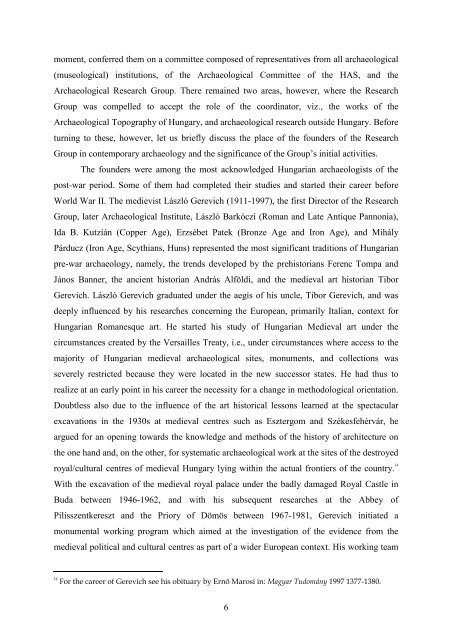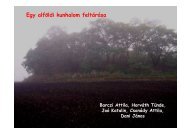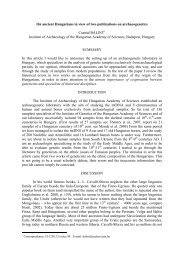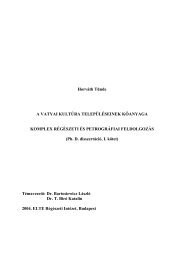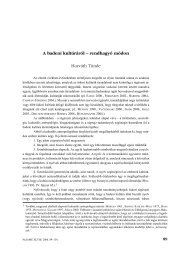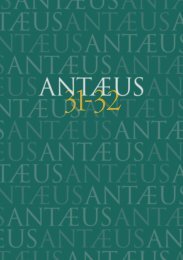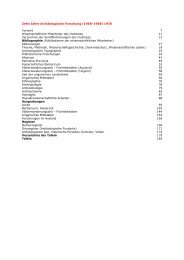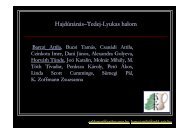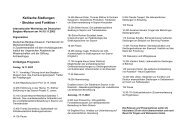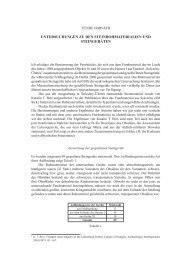The first forty-one years, 1958-19991 1. T - MTA Régészeti Intézet
The first forty-one years, 1958-19991 1. T - MTA Régészeti Intézet
The first forty-one years, 1958-19991 1. T - MTA Régészeti Intézet
You also want an ePaper? Increase the reach of your titles
YUMPU automatically turns print PDFs into web optimized ePapers that Google loves.
moment, conferred them on a committee composed of representatives from all archaeological<br />
(museological) institutions, of the Archaeological Committee of the HAS, and the<br />
Archaeological Research Group. <strong>The</strong>re remained two areas, however, where the Research<br />
Group was compelled to accept the role of the coordinator, viz., the works of the<br />
Archaeological Topography of Hungary, and archaeological research outside Hungary. Before<br />
turning to these, however, let us briefly discuss the place of the founders of the Research<br />
Group in contemporary archaeology and the significance of the Group’s initial activities.<br />
<strong>The</strong> founders were among the most acknowledged Hungarian archaeologists of the<br />
post-war period. Some of them had completed their studies and started their career before<br />
World War II. <strong>The</strong> medievist László Gerevich (1911-1997), the <strong>first</strong> Director of the Research<br />
Group, later Archaeological Institute, László Barkóczi (Roman and Late Antique Pannonia),<br />
Ida B. Kutzián (Copper Age), Erzsébet Patek (Bronze Age and Iron Age), and Mihály<br />
Párducz (Iron Age, Scythians, Huns) represented the most significant traditions of Hungarian<br />
pre-war archaeology, namely, the trends developed by the prehistorians Ferenc Tompa and<br />
János Banner, the ancient historian András Alföldi, and the medieval art historian Tibor<br />
Gerevich. László Gerevich graduated under the aegis of his uncle, Tibor Gerevich, and was<br />
deeply influenced by his researches concerning the European, primarily Italian, context for<br />
Hungarian Romanesque art. He started his study of Hungarian Medieval art under the<br />
circumstances created by the Versailles Treaty, i.e., under circumstances where access to the<br />
majority of Hungarian medieval archaeological sites, monuments, and collections was<br />
severely restricted because they were located in the new successor states. He had thus to<br />
realize at an early point in his career the necessity for a change in methodological orientation.<br />
Doubtless also due to the influence of the art historical lessons learned at the spectacular<br />
excavations in the 1930s at medieval centres such as Esztergom and Székesfehérvár, he<br />
argued for an opening towards the knowledge and methods of the history of architecture on<br />
the <strong>one</strong> hand and, on the other, for systematic archaeological work at the sites of the destroyed<br />
royal/cultural centres of medieval Hungary lying within the actual frontiers of the country. 14<br />
With the excavation of the medieval royal palace under the badly damaged Royal Castle in<br />
Buda between 1946-1962, and with his subsequent researches at the Abbey of<br />
Pilisszentkereszt and the Priory of Dömös between 1967-1981, Gerevich initiated a<br />
monumental working program which aimed at the investigation of the evidence from the<br />
medieval political and cultural centres as part of a wider European context. His working team<br />
14<br />
For the career of Gerevich see his obituary by Ern: Marosi in: Magyar Tudomány 1997 1377-1380.<br />
6


